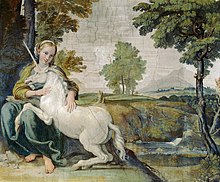
Back قصر فارنيزي Arabic Farnezi sarayı Azerbaijani Палацца Фарнезэ Byelorussian Палацо Фарнезе Bulgarian Palau Farnese Catalan Palác Farnese Czech Palazzo Farnese (Rom) German Παλάτσο Φαρνέζε Greek Palacio Farnesio Spanish Farnese jauregia Basque
| Palazzo Farnese | |
|---|---|
 Palazzo Farnese in Rome | |
 Click on the map for a fullscreen view | |
| General information | |
| Architectural style | Renaissance |
| Location | Rome, Italy |
| Coordinates | 41°53′41″N 12°28′15″E / 41.89472°N 12.47083°E |
| Client | Pope Paul III |
| Design and construction | |
| Architect(s) | Antonio da Sangallo the Younger Michelangelo Vignola |




Palazzo Farnese ([paˈlattso farˈneːze, -eːse]) or Farnese Palace is one of the most important High Renaissance palaces in Rome. Owned by the Italian Republic, it was given to the French government in 1936 for a period of 99 years, and currently serves as the French embassy in Italy.
First designed in 1517 for the Farnese family, the building expanded in size and conception when Alessandro Farnese became Pope Paul III in 1534, to designs by Antonio da Sangallo the Younger. Its building history involved some of the most prominent Italian architects of the 16th century, including Michelangelo, Jacopo Barozzi da Vignola and Giacomo della Porta.
At the end of the 16th century, the important fresco cycle of The Loves of the Gods in the Farnese Gallery was carried out by the Bolognese painter Annibale Carracci, marking the beginning of two divergent trends in painting during the 17th century, the Roman High Baroque and Classicism. The famous Farnese sculpture collection, now in the National Archeological Museum of Naples, as well as other Farnese collections, now mostly in Capodimonte Museum in Naples, were accommodated in the palace.
© MMXXIII Rich X Search. We shall prevail. All rights reserved. Rich X Search